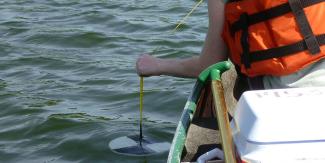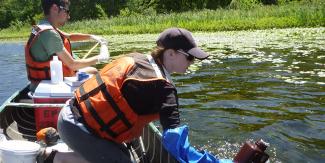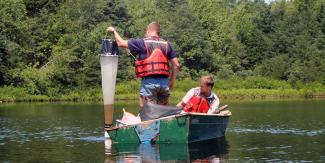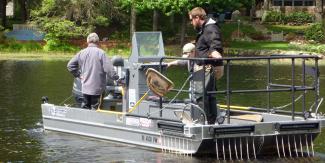Lake, Pond and Reservoir Monitoring
Water Quality Monitoring
Since 1988, the University of Rhode Island has coordinated a volunteer-based lake monitoring program as part of the Watershed Watch Program (URI-WW). This program is the primary source of water quality data on lakes and ponds in RI. Since 1999, the DEM Office of Water Resources has provided funding to URI-WW to support the program. Additional information about the program, parameters sampled, and detailed data are available online on their website.
Freshwater Beach Monitoring
About 50 freshwater licensed swimming beaches located on lakes are monitored pursuant to requirements of the RI Department of Health. The Department of Health recommends beaches be closed when bacteria levels are elevated and more information is available online on their website.
Monitoring Mercury in Fish Tissue
Since 2007, the DEM Office of Water Resources and Division of Fish & Wildlife along with the Environmental Protection Agency have collaborated to assess mercury contamination in freshwater fishin order to reduce a gap in data. During RIDEM surveys of fish community structure, which provide data on the number, size and species of fish, a sub-sample of fish is retained, and their tissues are analyzed for mercury at EPA laboratories. Most mercury in the environment is released into the air and is deposited on the large surface area of lakes, ponds and reservoirs. Mercury in the air can come from natural sources such as forest fires or volcanoes, but most sources include inputs from coal-fired power plants, municipal waste combustors, sewage incinerators and heating. Mercury deposited in freshwater is taken up by zooplankton and insects and then moves up the food chain accumulating in larger fish. Mercury is a potent neurotoxin that poses risks to human health when people are exposed to the metal by eating fish. The RI Department of Health (HEALTH) provides guidance on fish consumption online.
Invasive Plant Monitoring
Aquatic invasive species (AIS) are non-native plants and animals that have been introduced (accidentally or intentionally) into lakes and rivers, and whose introduction threatens the diversity or abundance of native species, the stability of the ecosystem and/or the use of the infested water body. AIS are a major threat to our freshwater ecosystems and a significant management concern because of their ecological and socio-economic costs. Since 2007, the Office of Water Resources has been surveying Rhode Island's freshwater rivers and lakes to map the state-wide distribution of aquatic invasive plants. Monitoring allows DEM personnel to determine which species are present in Rhode Island, where they are and to track their spread. DEM uses this information to prioritize where to direct future monitoring efforts to detect new invasions early, and to inform stakeholders about infestations in their lakes and the surrounding watershed.
Cyanobacteria (blue-green algae monitoring)
Cyanobacteria, also known as blue-green algae, are naturally found in many freshwater ecosystems. A combination of excess nutrients, sunlight, and high temperatures can lead to a rapid increase in cyanobacteria, called a “bloom.” Cyanobacteria blooms may look or smell bad, inhibit recreational activities or negatively affect water quality and other aquatic organisms. Some species of cyanobacteria can also produce toxins. These toxins are released when algae die-off or are ingested, posing a threat to human and animal health. Since 2011, RIDEM has developed monitoring protocols to screen for, respond to, and characterize blooms in the state’s fresh waters. In conjunction with RIDOH, the public may be advised to avoid contact and recreational activities on bodies of water experiencing blue-green algae blooms. View current and past lists of affected waterbodies.
Water Quality Restoration Monitoring
Additional data is also generated for specific lakes through water quality restoration studies by the TMDL program.




